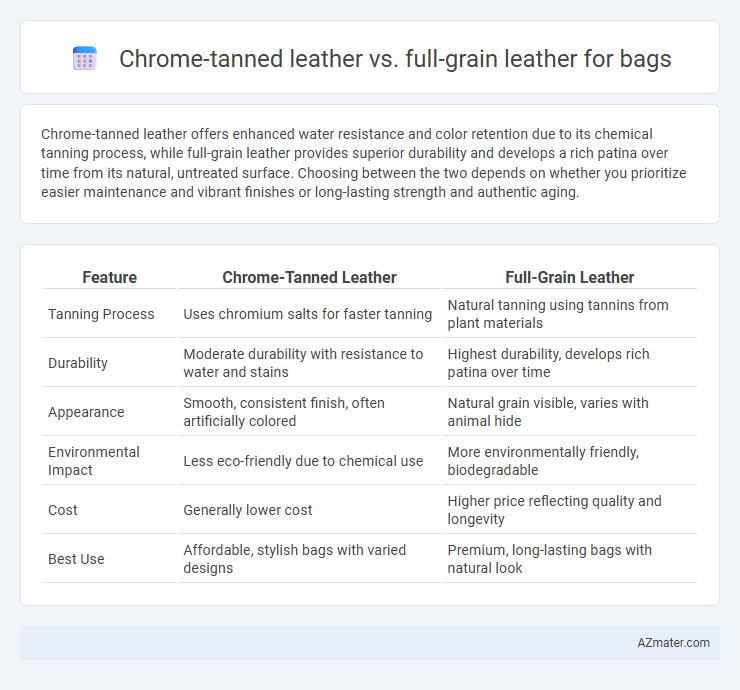Chrome-tanned leather offers enhanced water resistance and color retention due to its chemical tanning process, while full-grain leather provides superior durability and develops a rich patina over time from its natural, untreated surface. Choosing between the two depends on whether you prioritize easier maintenance and vibrant finishes or long-lasting strength and authentic aging.
Table of Comparison
| Feature | Chrome-Tanned Leather | Full-Grain Leather |
|---|---|---|
| Tanning Process | Uses chromium salts for faster tanning | Natural tanning using tannins from plant materials |
| Durability | Moderate durability with resistance to water and stains | Highest durability, develops rich patina over time |
| Appearance | Smooth, consistent finish, often artificially colored | Natural grain visible, varies with animal hide |
| Environmental Impact | Less eco-friendly due to chemical use | More environmentally friendly, biodegradable |
| Cost | Generally lower cost | Higher price reflecting quality and longevity |
| Best Use | Affordable, stylish bags with varied designs | Premium, long-lasting bags with natural look |
Introduction to Leather Types for Bags
Chrome-tanned leather for bags is treated with chromium salts, making it more flexible, water-resistant, and quicker to produce, appealing for fashionable, durable accessories. Full-grain leather retains the natural surface with minimal processing, offering superior strength, breathability, and an aging patina that enhances its character over time. Choosing between these types depends on the desired balance of durability, appearance, and environmental impact in bag craftsmanship.
What is Chrome-Tanned Leather?
Chrome-tanned leather is treated using chromium salts and chemicals that accelerate the tanning process, resulting in a softer, more pliable material ideal for bags requiring flexibility and water resistance. This tanning method preserves the leather's natural texture and enhances durability while providing vibrant color retention and resistance to stains. Compared to full-grain leather, chrome-tanned leather offers a more affordable, lightweight option with good longevity, though it may lack some of the strength and aging character found in vegetable-tanned full-grain leather.
Understanding Full-Grain Leather
Full-grain leather retains the entire grain layer, including natural markings and imperfections, making it the strongest and most durable leather for bags. Unlike chrome-tanned leather, which undergoes chemical tanning for a softer feel, full-grain leather ages beautifully, developing a unique patina over time. Its natural breathability and resistance to wear make it a premium choice for high-quality, long-lasting bags.
Durability: Chrome-Tanned vs. Full-Grain Leather
Chrome-tanned leather offers excellent durability with enhanced resistance to water and stains due to its chemical tanning process, making it ideal for everyday bags exposed to varying conditions. Full-grain leather, prized for its natural fibers and minimal processing, provides superior strength and ages gracefully with a unique patina, ensuring long-lasting durability and wear resistance. Choosing between the two depends on whether water resistance and low maintenance (chrome-tanned) or natural robustness and aging character (full-grain) are prioritized for bag longevity.
Appearance and Aging: Patina and Color Retention
Chrome-tanned leather exhibits consistent color retention with minimal patina development, maintaining a uniform appearance over time, ideal for those seeking vibrant hues and low maintenance. Full-grain leather develops a rich, natural patina through exposure and handling, enhancing its character with unique color variations and texture changes that deepen with age. The aesthetic appeal of full-grain leather lies in its ability to age gracefully, while chrome-tanned leather prioritizes stable coloration and a polished look throughout the bag's lifespan.
Water and Stain Resistance Comparison
Chrome-tanned leather offers superior water and stain resistance due to the chemical tanning process that tightly seals the hide, making it less prone to absorbing moisture and dirt, ideal for daily-use bags exposed to varying environments. In contrast, full-grain leather, prized for its natural grain and durability, is more susceptible to water and stains as its untreated surface absorbs liquids and oils, requiring regular conditioning and protective treatments to maintain its appearance. While chrome-tanned leather ensures easier maintenance and enhanced protection, full-grain leather provides a premium, breathable texture that develops a unique patina over time despite needing careful care against moisture and stains.
Environmental Impact of Tanning Methods
Chrome-tanned leather utilizes chromium salts, a process that significantly accelerates production but generates hazardous waste, leading to soil and water contamination if improperly treated. Full-grain leather, usually vegetable-tanned, employs natural tannins derived from tree bark and plants, resulting in a more eco-friendly method with biodegradable byproducts and lower chemical pollution. Choosing full-grain leather promotes sustainability by minimizing environmental harm associated with toxic chromium and supporting traditional, less industrial tanning practices.
Price Differences: Value for Money
Chrome-tanned leather is generally more affordable than full-grain leather due to a faster, less labor-intensive tanning process, making it a popular choice for budget-conscious buyers. Full-grain leather commands a higher price because of its durability, natural texture, and premium quality, offering better long-term value for bags that withstand wear and age gracefully. Consumers seeking cost-effectiveness often opt for chrome-tanned bags, while those prioritizing longevity and authentic leather aesthetics invest in full-grain options despite the higher upfront cost.
Suitability for Different Bag Styles
Chrome-tanned leather offers flexibility and water resistance, making it ideal for casual and fashion-forward bags such as backpacks and tote bags. Full-grain leather boasts durability and develops a rich patina over time, perfect for high-end, structured bags like briefcases and luxury handbags. Choosing between the two depends on whether the bag style prioritizes rugged longevity or modern aesthetics.
Choosing the Best Leather for Your Bag Needs
Chrome-tanned leather offers durability and water resistance, making it ideal for everyday bags exposed to varying conditions, while full-grain leather boasts natural breathability and develops a rich patina over time, enhancing its aesthetic appeal. Choosing the best leather depends on your priorities: opt for chrome-tanned if you need a low-maintenance, affordable option, or full-grain for premium quality and long-lasting elegance. Both types provide strength, but full-grain leather's organic texture and aging process appeal to those seeking a luxurious, unique bag experience.

Infographic: Chrome-tanned leather vs Full-grain leather for Bag
 azmater.com
azmater.com